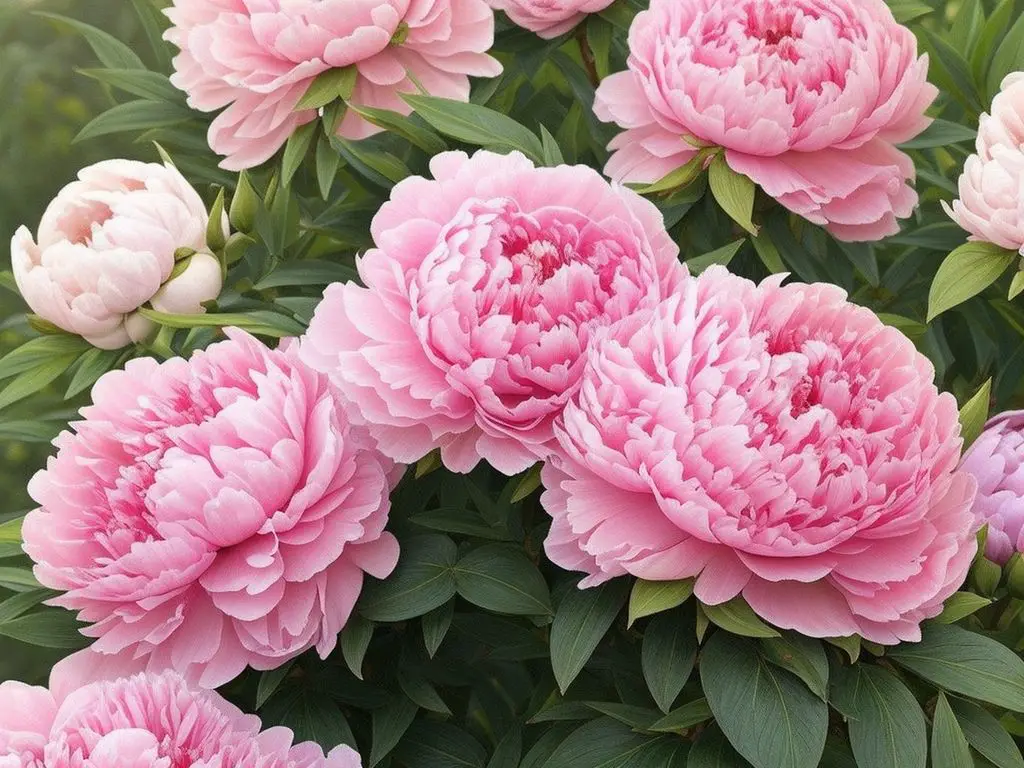.jpg)
Duchess of Kent Peony is a stunning and popular flower known for its elegant beauty and mesmerizing fragrance. In this article, we will provide an overview of the Duchess of Kent Peony, including its characteristics, cultivation, care, common issues and diseases, and harvesting and usage.
Duchess of Kent Peony is a herbaceous perennial plant that belongs to the Paeonia lactiflora family. It is characterized by large, double flowers with soft pink petals and a prominent yellow center. The flowers bloom in late spring to early summer, adding a touch of elegance to any garden or floral arrangement.
When cultivating Duchess of Kent Peony, it is important to understand its soil and sun requirements. This variety thrives in well-drained, fertile soil with a pH range of 6.5 to 7.5. It prefers full sun to partial shade, receiving at least 6 to 8 hours of sunlight a day.
Planting and propagation of Duchess of Kent Peony involves careful preparation of the soil and proper spacing of the plants. It is best to plant peony roots in the fall, ensuring they are positioned at a depth of 2 inches and spaced approximately 3 to 4 feet apart. Division is the most common method of propagation, typically done in early fall or early spring.
To care for Duchess of Kent Peony, adequate watering and regular fertilization are necessary. The plant should be watered deeply, keeping the soil moist but not waterlogged. Fertilizer rich in phosphorus should be applied in early spring and again after blooming to promote healthy growth and abundant flowering. Pruning and supporting the plant are also crucial to maintain its shape and prevent flopping.
As with any plant, Duchess of Kent Peony is susceptible to certain issues and diseases. Pest infestations, such as nematodes and ants, can pose a threat to the plant’s health. fungal diseases, including botrytis blight and powdery mildew, may affect the foliage and flowers. Proper sanitation, regular inspection, and appropriate treatment can help manage these problems effectively.
Harvesting Duchess of Kent Peony is a delightful experience. It is important to know the right time to harvest the flowers when they are in full bloom and the buds are showing color. These exquisite blooms can be used for various purposes, including floral arrangements, wedding bouquets, and home decorations. The Duchess of Kent Peony also holds medicinal value and is believed to have antioxidant and anti-inflammatory properties.
By understanding the characteristics, cultivation, care, common issues and diseases, and harvesting and usage of Duchess of Kent Peony, you can cultivate and enjoy the beauty and benefits of this exceptional flower in your own garden.
Key takeaways:
- Duchess of Kent Peony is a beautiful flowering plant: The Duchess of Kent peony is known for its stunning blooms and is a popular choice among gardeners for its vibrant colors and elegant appearance.
- Cultivating Duchess of Kent Peony requires proper care and maintenance: To successfully grow Duchess of Kent peony, it is important to provide the plant with suitable soil and sun conditions, and to regularly water, fertilize, prune, and support the plant.
- Duchess of Kent Peony can be harvested and used for various purposes: The flowers of Duchess of Kent peony can be harvested at the appropriate time and used for decorative arrangements, as well as in herbal remedies and cosmetics due to their potential health benefits.
Overview of Duchess of Kent Peony

Photo Credits: Fortheloveofgardeners.Com by Kevin Williams
Duchess of Kent Peony, a regal and exquisite flower, will take center stage as we explore an intriguing overview of this captivating botanical wonder. Discover the distinctive characteristics that make Duchess of Kent Peony stand out among its floral counterparts. From its vibrant hues to its enchanting fragrance, each sub-section within this exploration will unveil the remarkable qualities of this magnificent bloom. Get ready to immerse yourself in the fascinating world of Duchess of Kent Peony.
Characteristics of Duchess of Kent Peony
The Duchess of Kent Peony is known for its unique characteristics that make it a popular choice among gardeners. Here are some key features of this beautiful flower:
- Large, double blooms: The Duchess of Kent Peony exhibits stunning, fully double flowers that can reach up to 8 inches in diameter.
- Beautiful color variations: This peony variety showcases an array of colors, including shades of pink, white, and light purple.
- Strong fragrance: The blooms of the Duchess of Kent Peony release a delightful fragrance, adding to its appeal.
- Long blooming period: Unlike some other peonies, this variety boasts a prolonged blooming period, providing weeks of beauty in the garden.
- Hardiness: The Duchess of Kent Peony is a hardy plant that can withstand cold temperatures, making it suitable for various climates.
If you’re searching for a peony that embodies beauty, fragrance, and resilience, the Duchess of Kent Peony is an excellent choice for your garden. Its large, colorful blooms and captivating fragrance will surely enhance any outdoor space.
Cultivating Duchess of Kent Peony: Growing this stunning flower is like having a royal in your garden – it demands attention, but rewards you with majestic blooms fit for a queen.
Cultivating Duchess of Kent Peony

Photo Credits: Fortheloveofgardeners.Com by David Thompson
Growing the exquisite Duchess of Kent peony requires the right conditions and proper care. In this section, we’ll uncover the secrets to cultivating this regal bloom. From understanding its specific needs for soil and sun, to mastering the art of planting and propagation, we’ll dive into the key steps and techniques that will enable you to successfully nurture this enchanting flower. So, roll up your sleeves and let’s embark on a horticultural journey fit for royalty!
Soil and Sun Requirements
| Soil and Sun Requirements | |
|
The soil and sun requirements of Duchess of Kent Peony are important factors to consider for successful cultivation. Here is a table summarizing the necessary conditions for this peony variety: |
|
| Soil | Sun |
|
Well-draining soil |
Full sun to light shade |
|
Rich in organic matter |
At least 6 hours of direct sunlight per day |
|
pH level between 6.5 and 7.5 |
Avoid excessive shade, which can lead to weak stems and poor flowering |
Ensuring the Duchess of Kent Peony is planted in suitable soil and receives adequate sunlight will greatly contribute to its growth and blooming potential.
Planting and Propagation
- Planting and propagation of the Duchess of Kent Peony involves certain steps to ensure successful growth and propagation of this beautiful flower.
- Select a suitable location: Choose a spot with well-draining soil and full sun to partial shade for planting and propagation.
- Prepare the soil: Amend the soil with compost or organic matter to improve drainage and fertility, essential for planting and propagation.
- Dig a hole: Dig a hole that is wide and deep enough to accommodate the peony roots, promoting successful planting and propagation.
- Plant the peony: Place the peony root division in the hole, making sure the eyes (buds) are facing upward, facilitating planting and propagation.
- Backfill the hole: Fill the hole with soil, firming it gently around the roots to support planting and propagation.
- Water thoroughly: Give the newly planted peony a deep watering to settle the soil and hydrate the roots, aiding in their successful planting and propagation.
- Mulch: Apply a layer of organic mulch around the base of the plant to conserve moisture and suppress weeds, which is beneficial for planting and propagation.
- Provide support: Install plant supports like stakes or a peony ring to prevent the stems from flopping over, ensuring successful planting and propagation.
Prune like a pro and support your Duchess of Kent Peony, she deserves the royal treatment!
Care and Maintenance of Duchess of Kent Peony

Photo Credits: Fortheloveofgardeners.Com by Jason Garcia
Maintaining the beauty of your Duchess of Kent Peony requires proper care and attention. In this section, we will explore two essential aspects of its care: watering and fertilizing, and pruning and supporting. Discover the secrets to keeping your peony thriving with the right watering techniques and nourishment. Learn how to prune and provide the necessary support to ensure the sturdy growth and abundant blooms of your Duchess of Kent Peony. Let’s dive into the world of peony care and create a flourishing haven for these majestic flowers.
Watering and Fertilizing
Proper watering and fertilizing are crucial for the health and vitality of Duchess of Kent Peony plants.
- Watering: It is important to provide regular, deep watering to ensure that the soil remains consistently moist, without being waterlogged. It is best to avoid overwatering, as this can lead to root rot. In periods of drought, it is advisable to increase the frequency of watering.
- Fertilizing: For optimal results, it is recommended to apply a balanced, slow-release fertilizer either in early spring or after the plants have finished flowering. It is preferable to use a fertilizer specifically formulated for peonies or a general-purpose fertilizer with a ratio of 10-10-10. However, it is essential to avoid excessive fertilization, as this can result in weak stems.
Pro-tip: To retain moisture and prevent weed growth, mulch can be placed around the base of the plants.
Pruning and Supporting
Pruning and supporting are essential for maintaining the health and beauty of Duchess of Kent Peony plants. Here are some tips to help you with this task.
- To ensure optimal growth, it is necessary to engage in regular pruning. In early spring, it is advised to remove any dead or damaged stems and foliage. This practice encourages new growth and allows for better air circulation, preventing the onset of disease. Cutting the stems back to ground level is also recommended.
- To prevent the heavy blooms of Duchess of Kent Peony plants from toppling over, supporting them is crucial. This can be achieved by utilizing stakes or specialized peony rings. It is advisable to install these support structures early in the season to avoid causing harm to the plant.
I have experienced the consequences of neglecting pruning and supporting measures for my own Duchess of Kent Peony plants. Unfortunately, they ended up flopping over and sustaining damage due to strong winds. This served as a valuable lesson – in order to maintain the upright and healthy growth of these magnificent flowers, proper pruning and support are absolutely essential.
Common Issues and Diseases

Photo Credits: Fortheloveofgardeners.Com by Alexander Clark
Discover the common issues and diseases that can affect the beautiful Duchess of Kent peony. From dealing with pest infestations to combating fungal diseases, this section will provide insights and tips on how to keep your peony plants healthy and thriving. Uncover the challenges that these remarkable flowers may face and gain valuable knowledge to ensure their long-lasting beauty in your garden.
Pest Infestations
Pest infestations can have a detrimental effect on the health and growth of Duchess of Kent Peony plants. It is crucial to proactively prevent and manage these pests to ensure the well-being of your peony plants. Duchess of Kent Peonies can commonly be infested by pests such as aphids, spider mites, and nematodes. Inspecting your plants regularly for any signs of pest infestation, such as curled or discolored leaves, distorted growth, or the presence of insects, is essential. To control these pests, you have the option to use organic solutions like insecticidal soaps or neem oil. Additionally, maintaining good garden hygiene by removing debris or weeds can help deter and prevent pest infestations.
Watch out for those fungal diseases, they’re peony’s version of an unwanted houseguest that just won’t leave.
Fungal Diseases
Fungal diseases are a prevalent concern when it comes to cultivating Duchess of Kent peonies. It is crucial to take proper care and preventive measures in order to keep these diseases at bay. The following table provides a summary of common fungal diseases, their symptoms, and the control measures that should be taken for Duchess of Kent peonies:
| Fungal Disease | Symptoms | Control Measures |
|---|---|---|
| Botrytis Blight | Grayish-brown spots on leaves and stems | Removing infected plant parts and applying fungicides |
| Powdery Mildew | White, powdery patches on leaves | Improving air circulation and applying fungicidal sprays |
| Leaf Spot | Dark brown or black spots on leaves | Removing infected leaves and applying fungicides |
| Fusarium Wilt | Yellowing and wilting of the entire plant | Removing infected plants and avoiding replanting in the same area |
| Phytophthora Root | Wilting and yellowing of leaves, as well as root rot | Improving drainage and avoiding overwatering |
| Rot | Discolored, soft, and decaying plant tissues | Improving soil drainage and avoiding overwatering |
By staying vigilant and implementing these control measures, you can effectively protect your Duchess of Kent peonies from fungal diseases and ensure their healthy growth.
Harvesting and Using Duchess of Kent Peony

Photo Credits: Fortheloveofgardeners.Com by Kevin Lopez
Harvesting and using the captivating Duchess of Kent Peony opens up a world of possibilities. Discover the perfect timing for harvesting this regal flower and uncover the myriad of uses and benefits it offers. From its delicate fragrance to its therapeutic properties, delve into a realm where nature’s beauty and human creativity intertwine. Get ready to explore the art of maximizing the potential of Duchess of Kent Peony in ways you never imagined. Let’s embark on this enchanting journey together!
When to Harvest
When to Harvest Duchess of Kent peony depends on the stage of bloom and the intended use of the flowers. Here are some guidelines to help you determine the best time to harvest:
- For floral arrangements or bouquets, choose fully opened flowers.
- If you prefer longer-lasting blooms, wait until the flowers are 50-75% open.
- For seed production, allow the flowers to mature fully and wait for the seed pods to turn brown and begin to split.
- When you want to enjoy the flowers in your garden, harvest them at their peak of beauty.
Remember, different varieties may have different flowering times, so observe your individual plants closely. Enjoy the beauty of your Duchess of Kent peonies by harvesting them at the perfect time for your needs!
Uses and Benefits
The Duchess of Kent Peony offers a plethora of uses and benefits for both gardeners and enthusiasts alike.
- Garden Decoration: The beautiful blooms of the Duchess of Kent Peony make it a perfect choice for adding a touch of elegance to gardens and landscapes.
- Cut Flower Arrangements: With its large and fragrant blossoms, this peony variety is often utilized in floral arrangements for weddings and special occasions.
- Medicinal Purposes: Some believe that peonies, including the Duchess of Kent, possess medicinal properties and are utilized in traditional herbal medicine.
- Symbolism: Peonies are often seen as symbols of prosperity, honor, and good fortune, making the Duchess of Kent Peony a meaningful gift for loved ones.
Incorporating the Duchess of Kent Peony into your garden or floral arrangements can bring about numerous uses and benefits. It can enhance the beauty of your space, add elegance to your landscapes, and infuse positivity and prosperity through its symbolic representation. The Duchess of Kent Peony is also believed to have potential health benefits, further amplifying its value.
Some Facts About Duchess of Kent Peony:
- ✅ Duchess of Kent Peony is a low-maintenance deciduous shrub with large pink blooms.
- ✅ It belongs to the Paeoniaceae family and has a height of 1.2m and a spread of 90cm.
- ✅ The plant can tolerate dappled shade, full sun, and partial shade, making it suitable for various light conditions.
- ✅ It prefers moist, well-drained soil and can be planted in the middle of a border.
- ✅ Duchess of Kent Peony flowers from mid-spring to early summer and the blooms can be singles, semi-double, or multi-petalled, ranging in color from white to red.
Frequently Asked Questions
1. When will the Duchess of Kent peony bloom?
The Duchess of Kent peony blooms in mid-spring to early summer.
2. What is the flowering season of the Duchess of Kent peony?
The flowering season of the Duchess of Kent peony is from mid-spring to early summer.
3. Does the Duchess of Kent peony prefer rich soil?
Yes, the Duchess of Kent peony prefers rich soil, including clay, heavy, moist, well-drained, light, and sandy soil types.
4. Is there any reported toxicity to certain organisms for the Duchess of Kent peony?
No, there are no reported cases of toxicity to any specific organisms for the Duchess of Kent peony.
5. When is the best time to plant the Duchess of Kent peony?
The best time to plant the Duchess of Kent peony is during early autumn to mid-autumn.
6. What is the preferred sun exposure for the Duchess of Kent peony?
The Duchess of Kent peony can tolerate dappled shade, full sun, and partial shade. It is suitable for south-facing and west-facing aspects.

A passionate gardener and founder of ForTheLoveOfGardeners.com. She shares her expertise to help you cultivate thriving gardens and find joy in the beauty of nature.
